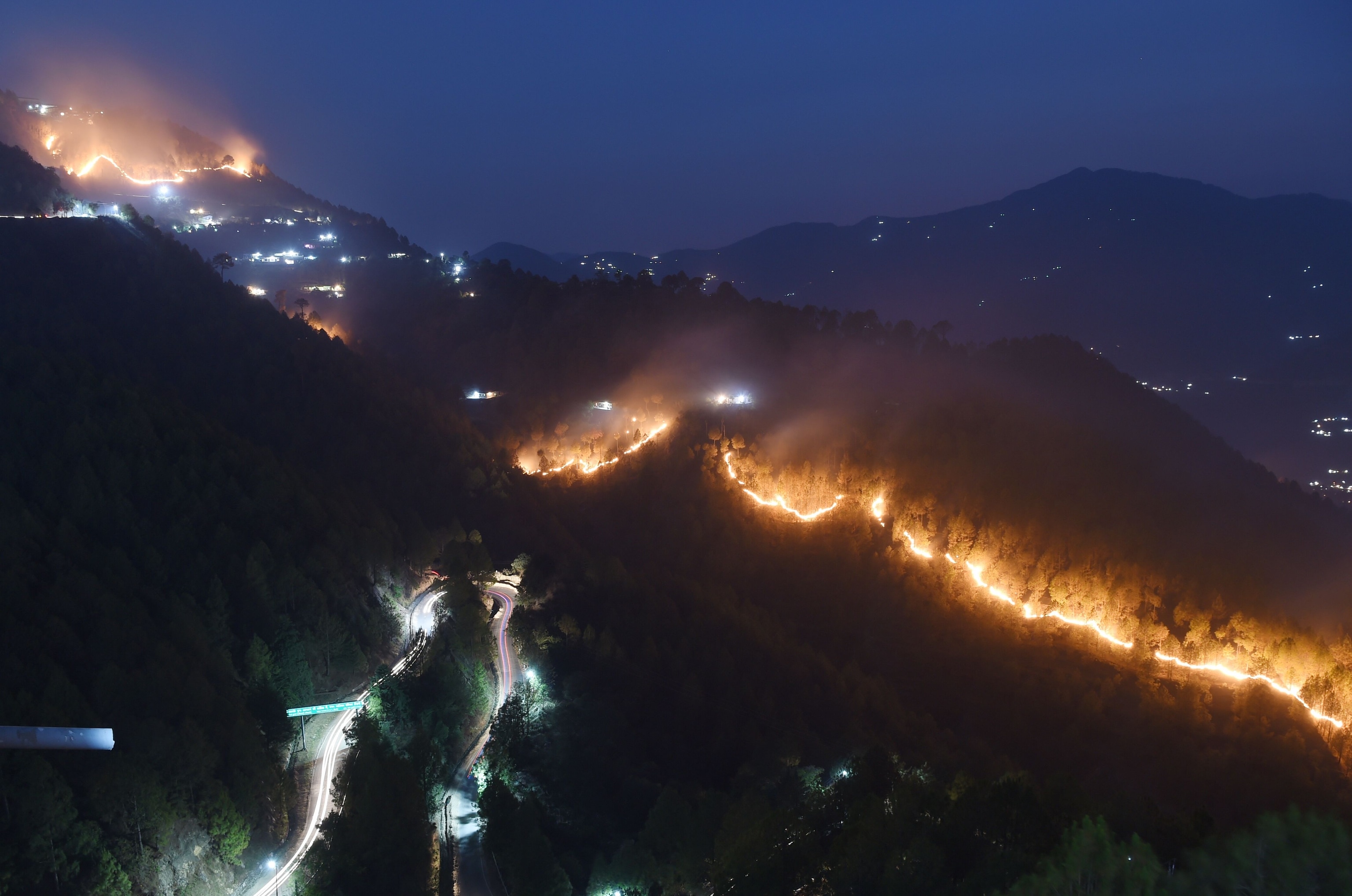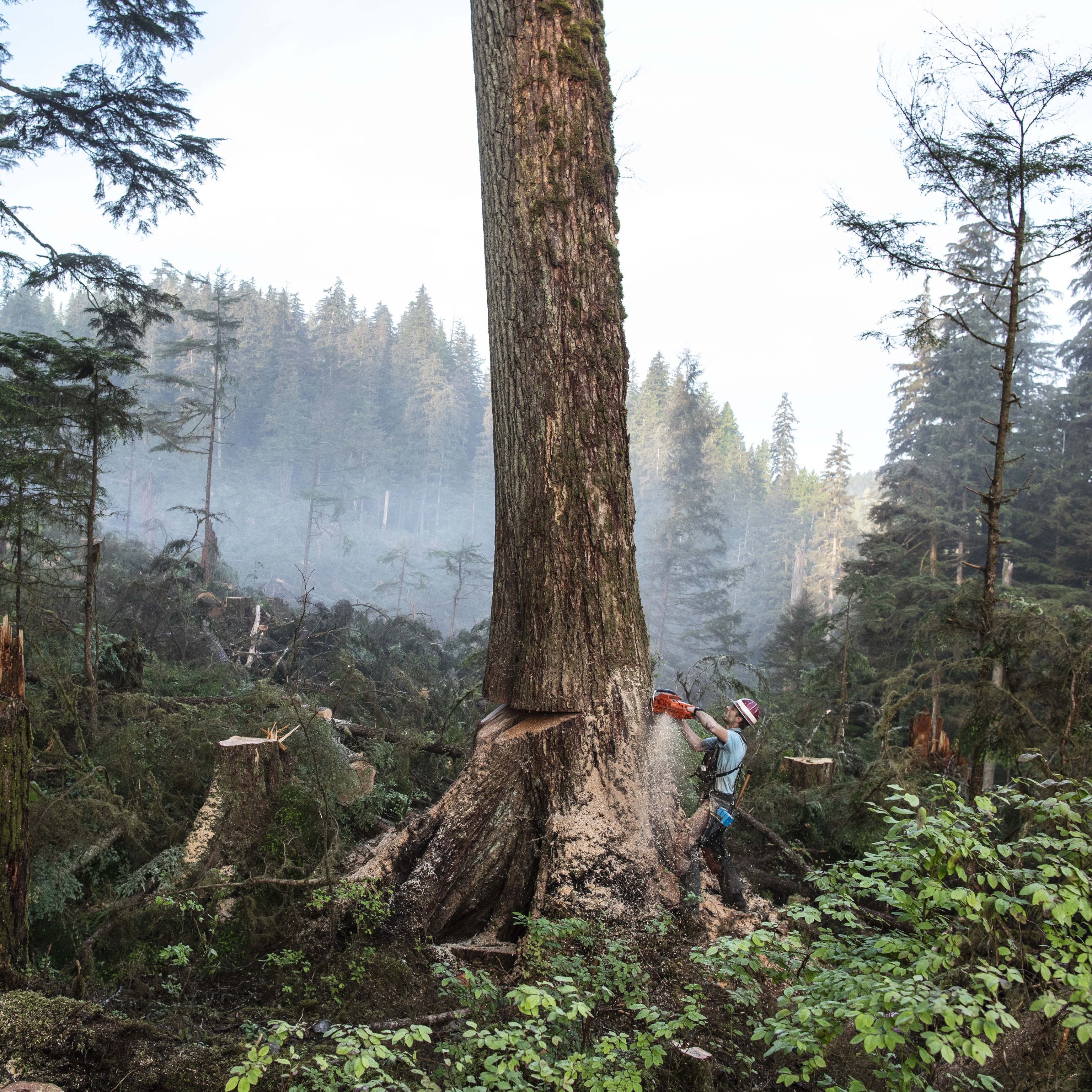
As wildfires increase in Himalayan pine forests, can restoring oaks help?
Heavy logging during the British colonial era and replanting with a single species—fast-growing pine—weakened forest health. Now, locals are making room for more oaks to regrow.
Parwara, India — In the Himalayan foothills of northern India, Vimla Bisht spends nearly every day gathering dry pine needles from the parched forest into a giant cloth sack, which she balances on her head for the long trek back home. She uses the needles to bed her cattle, though she collects them to safeguard her village against the drought’s side effects: fire.
Bisht, 32, lives in Parwara, a settlement of about 1,300 people that lies at 7,000 feet in the central Himalayas. Seasonal fires there have grown more ferocious as climate change remakes that landscape. Bisht and her neighbors serve as part of the front line in the effort to prevent the kinds of infernos that now occur yearly in Australia and California.
“We have not seen such furious forest fires before,” she says. “So, we now try to clear the forest floor of this menace as much as we can.”
But climate change isn't the only reason this landscape has become more fire prone. For more than a century, beginning in the late 1800s under British colonial rule, the native oak forests here were heavily logged, in part to build India's vast railway network. Over time the forests were replanted with fast-growing pine trees, with their highly flammable needles.
The effort to tidy the forest is one of a number of similar small restorative programs run by rural entrepreneurs in the region. Local campaigns—some successful—are underway to restore the native oak forests that largely have been replaced by pine and, for those collecting pine needles, a bioenergy nonprofit buys them to burn in eight small plants that generate clean electricity throughout the state of Uttarakhand, Parwara’s home state.
“This is small—micro-micro small—but the most important point here is that this electricity is coming out of the destructive energy of pine needles,” says Rajnish Jain, co-founder of the nonprofit, Avani. “This is helping clear up the forest floors, prevent forest fires, and conserve biodiversity.”
Fire season has become more intense
Fire season in the Himalayas begins in late fall and extends through spring until the monsoon rains begin. So far this winter, the erratic weather has delivered heavy snowfall, a relief compared to 2020, when fires that began in October burned continuously through April of 2021. But no one expects this year’s good weather fortune to last, and it’s still so early enough in the season that fire could occur before the rains begin.

Wildfires are not new to these foothills, but their frequency and the damage they cause have increased significantly in the last decade. Many experts called the 2020-2021 fire season the worst in a decade as more than 1,000 fires burned in the heavily forested Uttarakhand, which shares international borders with Nepal and China.
According to the European Union's Copernicus Atmospheric Monitoring Service (CAMS), the Uttarakhand forest fires emitted 0.2 megatons of carbon in just one month last year, the highest since 2003. Soot from the fires has also made its way to the high Arctic, sometimes in less than a week.
Aside from the warming climate, the region’s vulnerability to fire is caused in part by profound changes to the forests, which date to the 19th century and the British colonial period, when broadleaf oak forests were heavily logged by settlers and then replaced with fast-growing pine.
Forests remade as pine trees replaced native oak
That shift transformed northern India’s largely mixed forests into forests dominated by a single species. The native chir pine trees promised great commercial benefits, but weakened the region's fragile ecological balance in ways that were not fully recognized until fire season became more severe in the last decade.
The loss of oak forests was observed as early as 1874. That year, Hugh Cleghorn, the first Inspector General of Forests in India, told the Royal Scottish Arboricultural Society that “the government in India began to be seriously embarrassed by the scarcity of timber.”
In the years that followed, the British built what remains one of the world’s largest national railroad networks. They logged forests across India, including oak forests in the Himalayas, to manufacture the wooden railroad crossties between the rails. By 1910, the railway system had expanded to 51,650 kilometers (more than 32,000 miles) of tracks. The two world wars that followed created even greater demand for Indian lumber, as the British replaced scarce steel with wood to build ammunition boxes, rifle parts, and aircraft—and exported it as fuel for troops stationed abroad. In World War II alone, the British supplied “over a million tons of timber” to the army and the Indian Railway, according to a research paper on the role of India’s timber in the conflict.
As the market for pine resin expanded, the planting of pine plantations expanded with it, eventually turning India into one of the world’s largest producers.
Oak trees are the heroes of the native forest
Banj oak trees, known as the key to the health of the forest habitat, “attract rain and modulate surface water flow in streams and local weather patterns,” says Ghazala Shahabuddin, co-author of a study that found pine forests are expanding while native oak is declining. Pine trees regenerate quickly after a fire, while regeneration of oak takes longer, is more complicated, and often fails.
Pine pushes out oak, which can only germinate in wet soil and shaded areas. Oak seedlings have a high mortality rate in their first year, especially if conditions are too dry, and sometimes can take up to a decade to turn into saplings. These same conditions, on the other hand, are perfect for the tenacious pine. Protected by thick fire-resistant bark, pine does not burn. But it drops copious amounts of pine needles on the forest floor, sometimes knee deep, and dry pine needles creating the perfect tinder box to turn small fires caused by humans into intense, destructive blazes.
Even after the British left India, pine continued to be planted until 1980. Shahabuddin’s research found that oak forests cleared to establish chir pine plantations led to the “densification and spread of young pine stands.”
Today, Uttarakhand stands to lose “much of its hardwood forests and along with that, a significant chunk of its biodiversity, over time,” Shahabuddin says.
Help is on the way
Four years ago, an effort to restore the native forests and strengthen the ecosystem began when VNV Advisory, an organization that works to help communities impacted by climate change, launched a 30-year-long carbon offset project to plant oak over nearly 5,000 acres spread across 30 villages.
Sandeep Roy Choudhury, the group’s co-founder and director, says the plan “is to stop the progression of pine and bring back other local broad-leaved varieties.”
Back in Parwara, the daily sweeping of the forest floors continues. Every afternoon, stacks of brightly-colored cloth bags full of needles appear on the mountain slopes above the village waiting to be carried back to the village. The idea of cleaning needles from a forest floor seems an insurmountable chore, yet Bisht and others from the village are determined to succeed. “We won’t feed the fire,” she says.
The effort is already prompting change. At Avani, the biofuel company, Jain says the removal of the needles has done even more than diminish fire risk: It’s bringing back the forest.
“In patches from where the villagers have been removing pine needles continuously for the last four or five years, oak trees are coming back without any replanting efforts,” he says.








